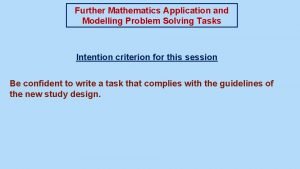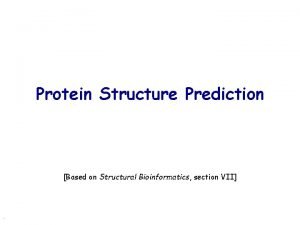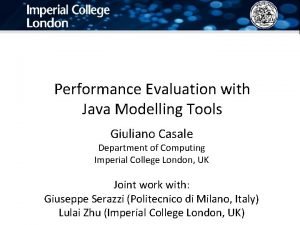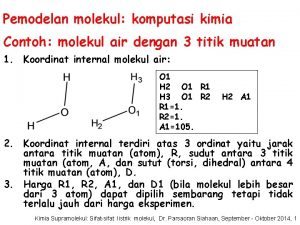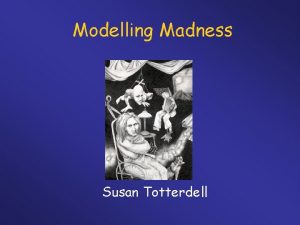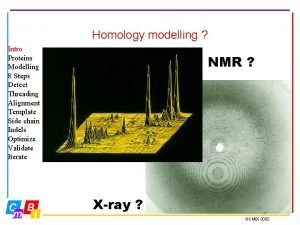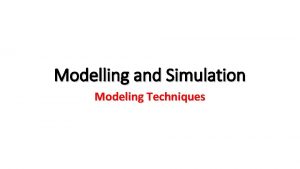Simulation and Modelling 4 Example of Simulation of










- Slides: 10

Simulation and Modelling (4) Example of Simulation of Queueing Systems Prof. Moheb Ramzy Girgis Department of Computer Science Faculty of Science Minia University

Simulation of Queueing Systems n… Simulations of QSs generally require the maintenance n n of an event list for determining what happens next. The event list tracks the future times at which the different types of events occur. Simulation clock times for arrivals and departures are computed in a simulation table customized for each problem. In simulation, events usually occur at random times, the randomness imitating uncertainty in real life. For example, it is not known with certainty when the next customer will arrive at a grocery checkout counter, or how long the bank teller will take to complete a transaction. Modeing & Simulation- Prof. Moheb Ramzy Girgis Dept. of Computer Science - Faculty of Science Minia University 2

Simulation of Queueing Systems n… In these cases, a statistical model of the data is n n developed from either data collected analyzed, or subjective estimates and assumptions. The randomness needed to imitate real life is made possible through the use of "random numbers". Random numbers are distributed uniformly and independently on the interval (0, 1). In a single-server QS, interarrival times and service times are generated from the distributions of these random variables. The examples that follow show such times are generated. Modeing & Simulation- Prof. Moheb Ramzy Girgis Dept. of Computer Science - Faculty of Science Minia University 3

Simulation of Queueing Systems E xample: … n n Consider a service facility with a single server. Assume 6 customers arrived at the facility one at a time. For simplicity, assume that the times between arrivals are in the range 1 to 6 and were generated by rolling a die five times and recording the up face. Table 2. 2 contains a set of five interarrival times generated in this manner. These five interarrival times are used to compute the arrival times of six customers at the QS. Note that, in general, for n customers we generate n-1 interarrival times. Modeing & Simulation- Prof. Moheb Ramzy Girgis Dept. of Computer Science - Faculty of Science Minia University 4

Simulation of Queueing Systems Interarrival times and The … first customer is assumed Table 2. 2. clock times to arrive at clock time 0. This Interarrival Arrival Times Customer starts the clock in operation. Time on Clock 1 0 The second customer arrives 2 2 2 two time units later, at a clock 3 4 6 time of 2. The third customer 4 1 7 5 2 9 arrives four time units later, at 6 6 15 a clock time of 6; and so on. n The second time of interest is the service time. Table 2. 3 contains service times generated at random from a distribution of service times. The only possible service times are 1, 2, 3, and 4 time units. Table 2. 3. Service Times Customer 1 2 3 4 5 6 Service Time 2 1 3 2 1 4 Modeing & Simulation- Prof. Moheb Ramzy Girgis Dept. of Computer Science - Faculty of Science Minia University 5

Simulation of Queueing Systems n Assuming that all four values are equally likely to occur, …these values could have been generated by placing the n numbers 1 through 4 on chips and drawing the chips from a hat with replacement, being sure to record the numbers selected. Now, the interarrival times and service times must be meshed to simulate the single-server QS. A Table 2. 4. Simulation table for the given problem B C D E Time Service Customer Arrival Time Begins (Duration) Ends 1 Number (Clock) 2 1 0 0 2 2 3 2 2 2 1 3 4 3 6 6 3 9 5 4 7 9 2 11 6 5 9 11 1 12 7 6 15 15 4 19 Modeing & Simulation- Prof. Moheb Ramzy Girgis Dept. of Computer Science - Faculty of Science Minia University 6

Simulation of Queueing Systems n As shown in Table 2. 4, the first customer arrives at clock … n n time 0 and immediately begins service, which requires two minutes. Service is completed at clock time 2. The second customer arrives at clock time 2 and is finished at clock time 3. Note that the fourth customer arrived at clock time 7, but service could not begin until clock time 9. This occurred because customer 3 did not finish service until clock time 9. Table 2. 4 was designed specifically for a single-server queue which serves customers on FIFO basis. It keeps track of the clock time at which each event occurs. The second column records the clock time of each arrival event, while the last column records the clock time of each departure event. Modeing & Simulation- Prof. Moheb Ramzy Girgis Dept. of Computer Science - Faculty of Science Minia University 7

Simulation of Queueing Systems n …The occurrence of the two types of events in chronological n order is shown in Table 2. 5 and Figure 2. 6. It should be noted that Table 2. 5 is ordered by clock time. Table 2. 5. Chronological Ordering of Events Event Type Arrival Departure Arrival Departure Customer Number 1 1 2 2 3 4 3 5 4 5 6 6 Modeing & Simulation- Prof. Moheb Ramzy Girgis Dept. of Computer Science - Faculty of Science Minia University Clock Time 0 2 2 3 6 7 9 9 11 12 15 19 8

Simulation of Queueing Systems … Figure 2. 6. Number of customers in the system n Figure 2. 6 depicts the number of customers in the system at the various clock times. It is a visual image of the event listing of Table 2. 5. Modeing & Simulation- Prof. Moheb Ramzy Girgis Dept. of Computer Science - Faculty of Science Minia University 9

Simulation of Queueing Systems …Customer 1 is in the system from clock time 0 to n n clock time 2. Customer 2 arrives at clock time 2 and departs at clock time 3. No customers are in the system from clock time 3 to clock time 6. During some time periods two customers are in the system, such as at clock time 8, when both customers 3 and 4 are in the system. Also, there are times when events occur simultaneously, such as at clock time 9, when customer 5 arrives and customer 3 departs. Modeing & Simulation- Prof. Moheb Ramzy Girgis Dept. of Computer Science - Faculty of Science Minia University 10
